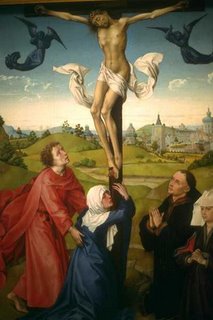 Dear students,
Dear students,Below is a brief biography of Jesus Christ, a little bit simplified by me. In some places I even put the Vietnamese version of some possibly unfamiliar words.Read and try to understand it properly, as such texts are extreamly useful for you to enrich the general knowledge.
I'll post similar articles about Prophet (tiên tri)Muhammad, fouder of Islamism (đạo Hồi) and Buddha (Đức Phật) of Buddhism.
Teacher Tan
________________
Jesus Christ (between 8 and 4 BC-c. AD 29), the central figure of Christianity, born in Bethlehem in Judaea. Jesus is believed by the great majority of Christians to be the Son of God, and to have been divinely conceived (thụ thai từ thần thánh) by Mary, the wife of Joseph, a carpenter of Nazareth. The name Jesus means deliverance (sự giải thoát). The title Christ means anointed one. The principal sources of information concerning Jesus' life are the Gospels (kinh Phúc âm), written in the latter half of the 1st century to facilitate the spread of Christianity throughout the ancient Western world.
Birth and Early Life
Two of the Gospels, those of St Matthew and St Luke, provide information about Jesus' birth and childhood. They also provide genealogies (phả hệ) tracing Jesus' descent through Abraham and David. Presumably, the genealogies are offered as proof of Jesus' messiahship. According to Matthew' gospel, (see 1:18-25) Jesus was miraculously conceived by his mother. He was born at Bethlehem, where Joseph and Mary had gone to comply with the Roman edict (lệnh) for the census (kiểm tra dân số). Matthew' Gospel alone describes the flight into Egypt, when Joseph and Mary took the child out of reach of the Judaean king Herod the Great. Only Luke' Gospel relates the compliance of Joseph and Mary with the Jewish law, which required circumcision (cắt bao qui đầu) and presentation of the first-born son at the Temple in Jerusalem; Luke also describes their later journey (see 2:41-51) with the young Jesus to the Temple for the Passover feast (lễ Vượt qua). The Gospels mention nothing concerning Jesus from the time he was 12 years old until the time he began his public ministry (thuyết giảng), about 18 years later.
Beginning of His Public Ministry
All three synoptic Gospels (the first three Gospels, so called because they present a similar overall view of the life of Christ) record Jesus' public ministry as beginning after the imprisonment of John the Baptist, and as lasting for about one year. The Gospel of John describes it as beginning with the choosing of his first disciples (see 1:40-51), and as lasting for perhaps three years.
Each Gospel describes the baptism nghi lễ tắm nước) of Jesus in the River Jordan by John the Baptist. Each reports that after the baptism Jesus retired to the neighbouring wilderness for a 40-day period of fasting (ăn chay) and meditation (suy ngẫm) and had to face the temptations brought forth by the devil.
After Jesus' baptism and retirement in the wilderness, he returned to Galilee, visited his home in Nazareth (see Luke 4:16-30), where his fellow Nazarenes objected to him, and then moved to Capernaum and began teaching there. About this time, Jesus selected 12 disciples (tông đồ) to work with him.
Growth of Jesus' Following (sự tin theo)
Using Capernaum as a base, Jesus, accompanied by his 12 chosen disciples, travelled to neighbouring towns and villages, proclaiming the advent (sự xuất hiện) of the kingdom of God, as had many of the Hebrew prophets before him. When the wounded in body and spirit asked help from him, he sought to heal them with the power of faith. He stressed the infinite (vô bờ bến) love of God for the lowest and weakest individuals, and he promised pardon and eternal life in Heaven to the most hardened sinners (người phạm tội nặng), provided their repentance (hối lỗi) was sincere. Pharisees, who feared that his teachings might lead to disregard (coi thường) for the authority of the Law. Other Jews feared that Jesus' activities and followers might prejudice the Roman authorities against any restoration of the monarchy.
Despite this growing opposition, Jesus' popularity, especially with social outcasts (tầng lớp nghèo) and the oppressed, increased. Eventually, the enthusiasm of his followers led them to make an attempt to “take him by force, to make him king”. Jesus, however, frustrated (bực mình) this attempt, withdrawing with his disciples by ship over the Sea of Galilee (Lake Tiberias) to Capernaum.
Jesus then divided his time into periods of travelling to cities in and outside the province of Galilee and periods of instruction (dạy) of his disciples, and retirement in Bethany and Ephraim, two villages near Jerusalem. Jesus spent most of his time in Galilee, and made numerous visits to Jerusalem. His discourses and the miracles (phép lạ) he performed at this time, particularly the raising (làm sống lại) of Lazarus in Bethany, made many people believe in him.
The Last Days
On the approach of Passover, Jesus travelled towards Jerusalem for the last time. On the Sunday before the Passover, Jesus entered Jerusalem, where he was met by crowds of people who acclaimed (hoan nghênh) him enthusiastically. There he drove (đuổi) from the Temple (đền thờ) the traders and money-changers who, by long-established custom (phong tục), had been allowed to do business in the outer court (sân ngoài), and he disputed (tranh luận) with the chief priests, the scribes (những nhà th ần học Do Thái), the Pharisees questions about his authority, tribute (đồ cống nạp) to Caesar, and the Resurrection (sự sống lại).
On Wednesday, Jesus was anointed (xức nước thơm) in Bethany. Meanwhile in Jerusalem the priests and scribes, concerned that Jesus' activities would turn the Romans against them and the Jewish people, conspired (âm mưu) with Judas, one of his disciples, to arrest and kill Jesus. On Thursday, Jesus ate the Passover supper with his disciples and during the meal referred (ám chỉ) to his imminent betrayal (sự phản bội sắp xảy ra) and death as a sacrifice (hy sinh) for the sins of humanity.
After the meal Jesus and his disciples went to the Mount of Olives, where Jesus said that he would be “raised up” (from the dead). Knowing then that the hour of his death was near, Jesus retired to the Garden of Gethsemane, where, he meditated and prayed. A crowd sent by the chief priests and the elders of the Jews, and led by Judas Iscariot, arrested him in Gethsemane.
Trial and Crucifixion (xét xử và đóng đinh)
Jesus was brought after his arrest to Annas, the father-in-law of the high priest Caiaphas, for a preliminary examination. At the council meeting, Caiaphas asked Jesus to declare whether he was “the Christ, the Son of God”. Upon his affirmation, the council condemned Jesus to death for blasphemy (tội phỉ báng). Jesus was taken to Golgotha and nailed to a cross, the Roman punishment for political offenders and criminals. Two robbers were crucified (đóng đinh lên thánh giá) also, one on each side of him. On the cross, above Jesus' head, “they put the charge against him, which read ‘This is Jesus the King of the Jews’”. Late in the day, his body was taken down, and because of the approach of the sabbath (ngày chúa nhật), when burial was not permitted, it was hastily laid in a nearby tomb by Joseph of Arimathea.
The Resurrection
Early on the following Sunday, “Mary Magdalene, and Mary the mother of James”, going to the tomb to anoint Jesus' body for burial, found the tomb empty. Inside the tomb, “a young man” clothed in white announced to them that Jesus had risen. Later on the same day, Jesus appeared to the women and to other of the disciples in various places in and around Jerusalem.
All the Gospels add that for a brief time after his Resurrection Jesus further instructed his disciples in matters pertaining (liên quan đến) to the kingdom of God. He also commissioned (ra lệnh) them to “Go … and make disciples of all nations, baptizing them in the name of the Father, and of the Son, and of the Holy Spirit” (Đức chúa cha, đức chúa con và các thánh thần). At Bethany Jesus was seen to ascend (bay lên) into the heavens. This occurred 40 days after Jesus' Resurrection.
Người viết: Thái Bá Tân
Nguồn ảnh: chưa biết
Nguồn bài: trang web của thầy tôi Thái Bá Tân




Không có nhận xét nào:
Đăng nhận xét